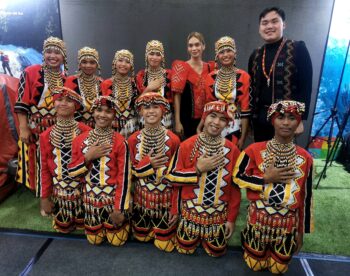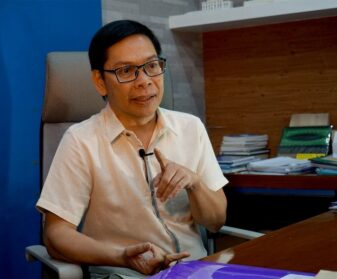
DAVAO CITY (MindaNews /02 May) – Way back in the angry 1960-70s at the height of the Vietnam war (that controversial war that erupted across Vietnam, Laos and Cambodia which began in November 1955 and lasted until the fall of Saigon on 30 April 1975), a number of anti-war songs arose in the American music landscape. One was entitled Where have all the flowers gone? The song found its way around the world making it an anthem of mostly student activists marching in the streets to protest against the Vietnam War from Paris to Perth, from San Francisco to Sao Paolo and from Madrid to Manila.
This song was composed by Pete Seeger way back in 1955, with additional lyrics by Joseph C. Hickerson. Seeger claimed that this song was inspired by a traditional Cossack folk song while he borrowed the music from an Irish lumberjack song. Seeger sang it in the concerts he was performing in the years that followed. But it was only the 1965 release of a record of the song as sung by The Kingston and released by Columbia Records that it began to soar to the heights of music fame.
Henceforth, all singers associated with the anti-war protest movement – from Bob Dylan to Joan Baez to Peter, Paul & Mary – and even those in the pop music scene (Bobby Darin, Harry Belafonte, Olivia Newton John & Dolly Parton) and the original boy bands (The Searchers, The Springfields, The Brothers Four & The Peddlers) all had their cover of this song.
There were also translations of the songs including French, Dutch, Hungarian, Russian, Polish, Czech and versions in the United Kingdom and Ireland. With the war raging now in Ukraine (this time Russians bombing Ukraine), this song must be resurrected by another generation of folksingers opposed to this present-day war.
This is one example of a “circular song,” meaning that it begins and ends with the same reference point and the lyrics keep on circling around. Thus the song goes this way:
Where have all the flowers gone, long time passing?
Where have all the flowers gone, long time ago?
Where have all the flowers gone? Young girls have picked them everyone.
(CHORUS). Oh, when will they ever learn? Oh, when will they ever learn?
In the next verses, the words “young girls” would shift to husbands, to soldiers, to graveyards and then back to flowers.
This song found its way across all possible venues on the planet earth from coffee shops to wherever there were jukeboxes, concert halls to chapels where rock Masses began to sprout, from the market places to streets where the song interspersed with the anti-war chanting and fiery speeches of celebrities like Jane Fonda. It galvanized the baby boomers (those born between 1946 to 1964), the generation who adopted this song as their anthem but was passed on to the next one, known as Gen X (born in 1965-1980) who in the Philippines were also referred to as the martial law babies.
We, the baby boomers, were the activists of the late 1960s to early 1980s who led the militant protest movement which began as a sign of solidarity with the youth of the world! However, we were just one more cycle in the circular narrative of Philippine history of the Mother Country’s youth who were willing to risk everything to serve the country.
They were mainly young men and women from the 1860s with the likes of Hermano Pule to the 1890s which produced that generation’s youth who are now know as our national heroes (the GOMBURZAs, Rizal, Bonifacio, Mabini, Jacinto, Luna, Del Pilar and those of La Solidaridad and Katipunan). Their movement led finally to the setting up of the first Republic in Asia.
But as the Americans took over as colonial power, another war was waged by a group of young men and women led by the likes of Macario Sakay. While it may have failed, it merely hibernated for a while. When the Japanese seized the opportunity to become our imperial master, another generation of men and women joined the anti-Japanese resistance, especially those who served as guerillas with the Hukbong Bayan Laban sa mga Hapon (Hukbalahap).
In the post-war era, some of them became the core of the newly established CPP and People’s Army – constituted mainly by the peasants in Central Luzon – who sustained the revolutionary fervor. During this period, President Ramon Magsaysay was provided enormous US military, technical and financial assistance. Because of the Cold War that raged at that time, the US government was pro-actively engaged in fighting the menace of communism across Asia. The Huk communist movement was vanquished but again only to hibernate for a while.
Another cycle in the 1960s was triggered by the Vietnam War. But the cause of the baby boomers-turned-activists in the Philippines – starting in Metro Manila but which spread to other urban centers across the country in the following decade – expanded to issues from that war to local concerns even as the then President Ferdinand Marcos was finishing his eight years’ term (and thus could no longer be allowed by the Constitution to run again).
There was always the issue of the landlessness problem of our peasants and the unjust conditions of our working class. But there was also the cancer of corruption spreading across the body politic (which worsened during the Marcos martial rule into a kleptocracy). Fueled by the Marx-Lenin-Mao ideological framework, they eventually pointed to the root causes of the country’s ills – feudalism, US imperialism and bureaucrat capitalism.
The inevitable conflict between a rising fascist State and a bourgeoning popular movement erupted into a violent collision in the late 1960s when it began to dawn on the nascent student movement along with the opposition and political opinion-makers that Marcos eventually would declare martial law. The protest movement took flight and the occasion was Marcos’ State-of-the-Nation-address (SONA) in Congress on January 15, 1970.
As Marcos gave his speech inside Congress, outside the students were screaming their slogans in what was generally a peaceful assembly. But the agitated police attacked them which led to skirmishes. In the aftermath, two students were killed and many were injured after a scrimmage at Manila’s Burgos. Thus began a series of events that ultimately would be referred to in Philippine history as the First Quarter Storm.
Marcos then used this supposedly unruly behavior of the youth as one reason for declaring martial law two years later as his presidential term was ending, clearly indicating his ambition to remain in power. Fast forward: in the next many years up to 1986, the youth’s militant protest movement soared even as the fascist State machinery became more brutal.
Human rights violations were being committed by the State apparatus all over the place against anyone suspected of being a “subversive.” As defined by the powers-that-be, this meant anyone opposed to martial rule. Eventually, as the conscientizing and organizing work spread across all the sectors of society and more people saw the evils of authoritarian rule, a people’s movement against the tyrannical dictatorship grew by leaps and bounds which culminated in EDSA I in 1986.
What happened then to all those young people – now not just the baby boomers but also Gen X– after 1986? Most of them hibernated: found jobs, got married, raised children and avoided political engagements. But there were those who remained politically involved. However, there arose a split in the ranks of the militant movement into the radical and moderate groups (RJ vs RA). The former aligned themselves with the persistent armed struggle while the latter took the path of legal and engaged (aka non-violent) political alignments and consolidated the civil society movement.
Then Duterte appeared on the national political stage. Some of the ex-activists of the martial rule period saw a messiah in him and no matter their Marxist-Leninist-Maoist orientation, they not just embraced his populist politics but even joined government and turned Duterte apologists. One even headed the most influential troll farm that became one reason why Duterte won, thus proving that fake news and disinformation could influence voters.
Their ex-comrades who remained against any form of human rights violations began to wonder why their former kaubans/kasama could justify the hundreds of extra-judicial killings taking place. For they found ways to justify the President’s brutal war on drugs. Various explanations surfaced but still many of us shook our heads, not comprehending why their radical kaubans shifted from left to right. One could read these in articles published in journals, in online blogs or postings in Facebook (like the one that my confrere, Fr. Amado Picardal CSsR wrote).
And this question has persisted up to this political season because the daughter of the beloved patriarch is running as Vice President. Some of those who remain loyal to the President who hails from Mindanao/Davao have totally rejected their past, perhaps even regarding their youthful idealism as a waste of time. They are even complicit to historical revisionism. They have no qualms about being fully endorsing the UnityTeam.
In Davao, that means fully supporting two other Dutertes running for office. On the other hand, there are those who have ambivalent feelings about BBM (Bongbong Marcos), having formerly opposed vehemently the candidate’s dictator-father martial rule. So they will not vote for BBM but are solidly behind SD (Sara Duterte), thus some even promote the alternative RoSa (Robredo-Sara).
Finally, there is the rest of us baby boomers now in the twilight of our years who if we married and whose children have children would now have grandchildren. In this tumultuous year which we hope is when the pandemic will finally exit the planet, we are still attending rallies whose politically-charged color has shifted from red to pink. (I still fume how the BBM-Sara camp usurped the revolutionary color of red when it was a color that dethroned the father-dictator! But that is another story.)
Attending these rallies and shaking their heads how their form/style/atmosphere unfold before their eyes, they have mixed feelings: nostalgia for the bygone years when theirs were angrier and grittier, a sense of wonder how zumba and Vice Ganda can mix with activism but eventually delight at how another “revolutionary” cycle is historically unfolding in the here and now! We look around and we realize that we the elderly constitute only a miniscule minority as the rest of us would rather stay home and cover the events via online live-streaming. For the great majority of those screaming at these huge crowds – but also dancing and having fun! – are those of Generations Y and Z.
But we the baby boomers are still there at the barricades as part of the sea of pink! I have attended three of these and watched a few online and I found myself enmeshed in a flood of emotions! And I prayed intensely: let this generation hold on to the fire of this kind of conviction that gives rise to a spirit that would defy all odds despite the dangers that lurk ahead! For the future is considerably uncertain no matter the result of the May 9 elections. But we who took pride that we did possess that kind of conviction could walk towards the sunset fully confident that our grandchildren are resuming the struggle of generations to build a truly free, just, truthful, sovereign and compassionate nation-state!
Still there is need to ask – but what about this phenomenon of our ex-kaubans who abandoned the cause? Pray tell, why would those who risk their lives fighting the Marcos dictatorship are today joining the bandwagon to make sure that the BBM-Sara tandem will rule the Republic in the next six years? To answer this question, perhaps we will need to quote another anti-war song (one that Bob Dylan wrote in 1962): “The answer my friend is blowing in the wind, the answer is blowing in the wind!”
[MindaViews is the opinion section of MindaNews. Redemptorist Brother Karl Gaspar is a professor at St. Alphonsus Theological and Mission Institute (SATMI) in Davao City and until recently, a professor of Anthropology at the Ateneo de Davao University. Gaspar is author of several books, including “Manobo Dreams in Arakan: A People’s Struggle to Keep Their Homeland,” which won the National Book Award for social science category in 2012, “Desperately Seeking God’s Saving Action: Yolanda Survivors’ Hope Beyond Heartbreaking Lamentations,” and his latest, “Handumanan (Remembrance): Digging for the Indigenous Wellspring.”. He writes two columns for MindaNews, one in English (A Sojourner’s Views) and the other in Binisaya (Panaw-Lantaw). Gaspar is a Datu Bago 2018 awardee, the highest honor the Davao City government bestows on its constituents.]







